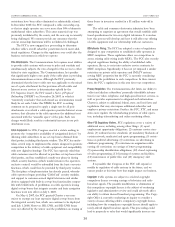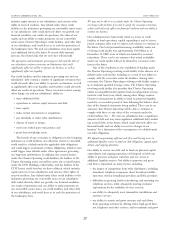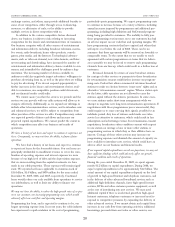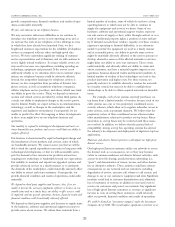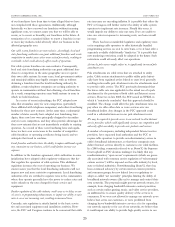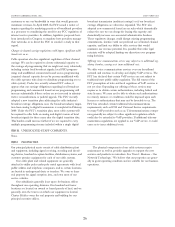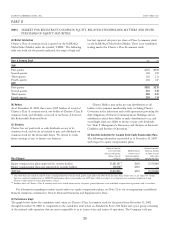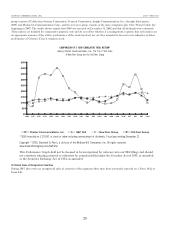Charter 2007 Annual Report Download - page 32
Download and view the complete annual report
Please find page 32 of the 2007 Charter annual report below. You can navigate through the pages in the report by either clicking on the pages listed below, or by using the keyword search tool below to find specific information within the annual report.
growth, competitiveness, financial condition, and results of oper-
ations could suffer materially.
We face risks inherent in our telephone business.
We may encounter unforeseen difficulties as we continue to
introduce our telephone service in new operating areas and as
we increase the scale of our telephone service offerings in areas
in which they have already been launched. First, we face
heightened customer expectations for the reliability of telephone
services as compared with our video and high-speed data
services. We have undertaken significant training of customer
service representatives and technicians, and we will continue to
need a highly trained workforce. To ensure reliable service, we
may need to increase our expenditures, including spending on
technology, equipment and personnel. If the service is not
sufficiently reliable or we otherwise fail to meet customer expec-
tations, our telephone business could be adversely affected.
Second, the competitive landscape for telephone services is
intense; we face competition from providers of Internet tele-
phone services, as well as incumbent telephone companies,
cellular telephone service providers, and others, which may limit
our ability to grow the service. Third, we depend on intercon-
nection and related services provided by certain third parties. As
a result, our ability to implement changes as the service grows
may be limited. Finally, we expect advances in communications
technology, as well as changes in the marketplace and the
regulatory and legislative environment. Consequently, we are
unable to predict the effect that ongoing or future developments
in these areas might have on our telephone business and
operations.
Our inability to respond to technological developments and meet cus-
tomer demand for new products and services could limit our ability to
compete effectively.
Our business is characterized by rapid technological change and
the introduction of new products and services, some of which
are bandwidth-intensive. We cannot assure you that we will be
able to fund the capital expenditures necessary to keep pace with
technological developments, or that we will successfully antici-
pate the demand of our customers for products and services
requiring new technology or bandwidth beyond our expectations.
Our inability to maintain and expand our upgraded systems and
provide advanced services in a timely manner, or to anticipate
the demands of the marketplace, could materially adversely affect
our ability to attract and retain customers. Consequently, our
growth, financial condition and results of operations could suffer
materially.
We depend on third party suppliers and licensors; thus, if we are
unable to procure the necessary equipment, software or licenses on rea-
sonable terms and on a timely basis, our ability to offer services could
be impaired, and our growth, operations, business, financial results and
financial condition could be materially adversely affected.
We depend on third party suppliers and licensors to supply some
of the hardware, software and operational support necessary to
provide some of our services. We obtain these materials from a
limited number of vendors, some of which do not have a long
operating history or which may not be able to continue to
supply the equipment and services we desire. Some of our
hardware, software and operational support vendors represent
our sole source of supply or have, either through contract or as a
result of intellectual property rights, a position of some exclusiv-
ity. If demand exceeds these vendors’ capacity or if these vendors
experience operating or financial difficulties, or are otherwise
unable to provide the equipment we need in a timely manner
and at reasonable prices, our ability to provide some services
might be materially adversely affected, or the need to procure or
develop alternative sources of the affected materials or services
might delay our ability to serve our customers. These events
could materially and adversely affect our ability to retain and
attract customers, and have a material negative impact on our
operations, business, financial results and financial condition. A
limited number of vendors of key technologies can lead to less
product innovation and higher costs. For these reasons, we
generally endeavor to establish alternative vendors for materials
we consider critical, but may not be able to establish these
relationships or be able to obtain required materials on favorable
terms.
For example, each of our systems currently purchases set-
top boxes from a limited number of vendors, because each of our
cable systems uses one or two proprietary conditional access
security schemes, which allow us to regulate subscriber access to
some services, such as premium channels. We believe that the
proprietary nature of these conditional access schemes makes
other manufacturers reluctant to produce set-top boxes. Future
innovation in set-top boxes may be restricted until these issues
are resolved. In addition, we believe that the general lack of
compatibility among set-top box operating systems has slowed
the industry’s development and deployment of digital set-top box
applications.
Malicious and abusive Internet practices could impair our high-speed
Internet services.
Our high-speed Internet customers utilize our network to access
the Internet and, as a consequence, we or they may become
victim to common malicious and abusive Internet activities, such
as peer-to-peer file sharing, unsolicited mass advertising (i.e.,
“spam”) and dissemination of viruses, worms, and other destruc-
tive or disruptive software. These activities could have adverse
consequences on our network and our customers, including
degradation of service, excessive call volume to call centers, and
damage to our or our customers’ equipment and data. Significant
incidents could lead to customer dissatisfaction and, ultimately,
loss of customers or revenue, in addition to increased costs to
service our customers and protect our network. Any significant
loss of high-speed Internet customers or revenue, or significant
increase in costs of serving those customers, could adversely
affect our growth, financial condition and results of operations.
We could be deemed an “investment company” under the Investment
Company Act of 1940. This would impose significant restrictions on us
CHARTER COMMUNICATIONS, INC. 2007 FORM 10-K
21





